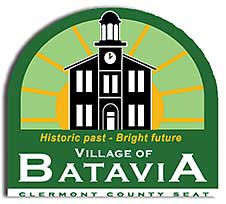 Batavia is celebrating its bicentennial this year, and The Clermont Sun is publishing a series of historic vignettes. The late Rosanna Hoberg, author, was a columnist and reporter for The Clermont Sun. This column was published in 1964.
Batavia is celebrating its bicentennial this year, and The Clermont Sun is publishing a series of historic vignettes. The late Rosanna Hoberg, author, was a columnist and reporter for The Clermont Sun. This column was published in 1964.
By Rosanna Hoberg
Batavia in the late 1800s had four manufacturing machine shops, two foundries, a brick plant, two banks, three printing shops, seven churches, three hotels, four barbershops, 16 stores, two bakeries, five physicians, two dentists, one undertaker, 20 lawyers, 10 lodges, two pool halls, three restaurants, 42 automobiles, two livery stables, two blacksmiths shops, two tin shops, one jewelry shop, one garage, two implement dealers, five insurance agencies, eight rooms in public schools, one flouring mill, one tailor shop, and one drug store.
The town during these years was like one big family. The people shared each other’s joys and sorrows. Everybody knew everybody on the streets and spoke to them and visited with them in the evenings. They all shared a sense of pride when Hugh Nichols climaxed an active life of service as State Senator and Lieutenant Governor of Ohio, by being appointed the first Chief Justice of the Supreme Court that the state had ever had, and they then helped to elect him to that office for many terms of service.
Then after a few short years, there were more sorrows than joys, when the town once again was called upon to send its youth into service during World War I. One hundred thirty-nine Batavians answered the call, and two, Everett Hockett and Frank Weaver, didn’t come back. One family had the distinction of having four brothers in service, Allen, John, Percy and Thomas Ashburn were all officers of high rank. At home, the people did their part. The young folk held dances at the Armory; the women knitted, rolled bandages for the Red Cross, and sold war bonds, and first thing they knew, the War was over.
The boys came back and took up their village lives again. There was now a machine shop, which offered jobs to the veterans, and there was first a heel factory, then an overall factory, on the top floor of the Jamieson building. There was a creamery on Victoria Avenue, and lots were being sold in the new subdivision behind the schoolhouse for $200. There was a brickyard and several coal yards; there was Rev. Edmund Burdsall, a retired Methodist minister and Civil War veteran, who conducted marriage ceremonies for half the couples in Clermont County; there was Pegg’s Ice Cream Parlor, Nash’s Pharmacy and Jarmon Naylor’s confectionary shop.
You could play miniature golf at Tyler’s Island, go to Mr. Robinson’s picture show, or enjoy the extra-special treat of one of Jack Jamieson’s home talent shows; then, too, in summer there was always Bartone’s medicine show in a tent in Bishop’s yard, and early summer evenings brought the melodious voice of Orie Frazier’s victory cry if the Reds won a ball game; the radio reached the pinnacle of its popularity during the ’30s, and it was a thrill to listen to the voice of Roy Battles, a fellow Batavian, on ‘‘Everybody’s Farm.” For the sports-minded, there were always the exciting high school basketball games at the Armory. The people went to the polls on Election Day and helped elect Harold D. Nichols state senator, a post his uncle had held many years earlier.
This was a period of varied circumstances. For a few years after the War, the town was busy with returning veterans making plans for great progress, and for a time prosperity seemed to reign everywhere. Then came the Depression years, and at no time in the history of the town did the people feel more lost. They shook their heads and weathered the storm, though, and nobody jumped out of any windows. Storekeepers extended credit, and doctors forgot bills and then came the days of WPA. Batavia’s youth, when they couldn’t find jobs, joined the CCC and planted trees; those who stayed home, needing to expedite their spending money, became members of the Ohio National Guard, under the leadership of Captain Forrest Ely.
Excerpted from History of Batavia, Ohio, 1814–1965, by Rosanna Hoberg. Some references are added to reflect 2013 circumstances.
